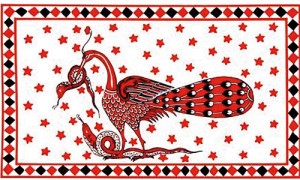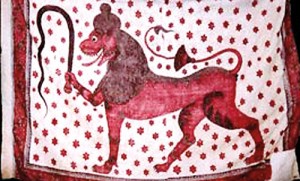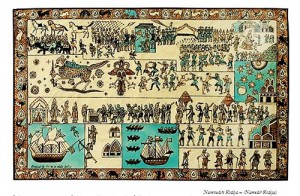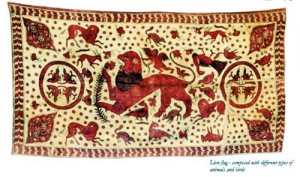Artistic and imaginative: Flags of the Udarata Kingdom
E.W. Perera’s ‘Sinhalese banners and standards’ (1916) was the first book which drew attention to the flags of the Udarata kingdom. This book only had 95 flags because the monks of leading temples refused to cooperate and had not sent all their flags. Nimal de Silva’s “Flag traditions of Sri Lanka” (2013) however, lists over 300 flags from 17th century to 19th century, preserved in Buddhist temples. Many were found in Raja Maha Viharas, including several Uva disawa flags. The monks had not wanted to show flags to de Silva either and he had to search around and find them. He found one gifted by king Rajadhi to a temple. A royal flag with lion holding a whip was found in Saman devale.

Each province had its own flag with clear borders, decorative motifs and a single symbol in the centre. The Tumpane flag showed a lotus and Udunuwara had a kindura. Four flags featured birds, Tun korale (peacock), Bintenne (parrot), Walapane (mayura) (pictured) and Uva (swan)
De Silva says Dutugemunu’s flag at the Dambulla rock cave depicts a lion and sword. The flag of Parakrama Bahu VI (1470-1478), according to ‘Parakumba Sirita’ also showed a lion. Thereafter, the lion has been drawn holding a whip. Today a whip is seen as an instrument of torture, but this whip, I think, indicated supreme power. In the Udarata, the king and the adigars, who represented the king, were preceded by kasakarayo cracking whips. The seal of Dharmapala (1551-97) found in a letter sent to the Queen of Portugal, had a lion holding a whip. The terracotta eave tiles in Kotte royal palace also had a similar lion. In the time of Wimaladharmasuriya I there were two flags, one was of a lion holding whip and curly long tail, other holding a sword. The cloth case of a talpat given to Dutch governor Simon during the reign of Wimaladharmasuriya II (1687-1707) had a lion carrying a whip in its paw. The seal of the Maha vasala of Wimaladharmasuriya II, however, had a lion with right leg raised. The lion flag of Sri Wickrema with a sword and curly tail was found in Chelsea hospital, London. Perera’s book also contained many lion flags. It had lots of sinha kodi from Tamankaduwa.
Each province had its own flag. This was known as the delkodiya (dela meant office). Matale Maha disawani had sudu maha kodiya. This was white without any decoration. The Satara korale flag had four tassels adorned with three varieties of rubies. Sabaragamuwa’s muthu dal kodiya was gold coloured and decorated with rows of pearls. The Ira Handa Kodiya, however, took precedence over all provincial flags. It was the Jaya Kodiya, flag of victory, awarded to the province which showed great heroism in war. The province which received it’as precedence over all other provinces as well. King Wimaladharmasuriya I gave it to Matale and King

A royal flag with lion holding a whip
Senerat to Sat Korale. Rajasinghe II gave it to Satara korale. The ‘ira handa kodiya’ was thereafter carried ahead of the Satara korale flag in processions.
The flags had clear borders, decorative motifs and a single symbol in the centre. The Tumpane flag showed a lotus and Udunuwara had a kindura. Four flags featured birds, Tun korale (peacock), Bintenne (parrot), Walapane (mayura) and Uva (swan). Animals were included. The Tamankaduwa flag featured a bear. Vellassa had a leopard and Harispattuwa had two elephants, male and female, confronting each other. Sat korale had the Sinha Rohana flag, with the lion looking over the right shoulder.
These flags were symbols of office as well. The Disawe of a province was given the flag of the disawani he governed. This flag, the lekam miti and the mura ayudha were kept under

Nambudiri Caste Flag and the ‘Lion flag’
guard, in the Atapattu maduva near the disava’s house. Molligoda handed over the Satara korale flag when he defected to the British in 1815. Ahalepola had earlier, in 1814, offered to hand over the flag and lekam miti of Sabaragamuwa to the British Governor. The various royal departments also had flags. The Nanayakkara had the nil pata kodiya. Flags remained in the family even after the person who had been given the appointment had died and noble families were able to show flags bestowed on them by the king. Flags differed in size and the rank of the flag was indicated by the size. The Jaya kodiya was the largest.
There were shilpa texts, for designing and making flags. The white cloth, silk or cotton, was first soaked in a light milk solution and then dried well before drawing the design by hand. The pattern held together because of the milk solution. The flag was later washed and dried before use. The sizes for each flag and the ‘inner proportions’ were specified.

which is illustrated with animals and birds
The shilpa text Chandrakulamalaya contained information on the decorative flag which had to be flown when a chaitya was inaugurated. Nimal de Silva made a copy of this flag, using the meticulous descriptions and specific measurements given in the text. He found that this flag was not in use in Sri Lanka any more. However, he came across the identical flag in a local temple in Laos. The King of Laos had wanted the Buddhism practised in Sri Lanka to be introduced to his kingdom and this flag had arrived with the rest of the tradition.
Robert Percival said the Udarata flags contained ‘many hideous creatures’. That is not so. The Udarata flags are very artistic. The Udarata painter had a wonderful imagination. The birds are presented in fantasy style. There are beautiful variants of the swan in the Uva flag. De Silva’s book shows four versions. The monara, gurulu, mayura and hansa flags in Perera’s book are also very beautiful. These flags should be included in any study of Udarata painting.
The writings of Nimal de Silva, E.W. Perera, P.E. Pieris, Ralph Pieris and T. Vimalanananda, were used for this essay.


